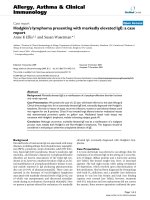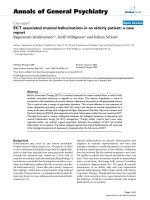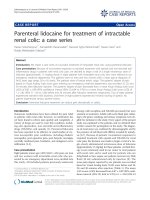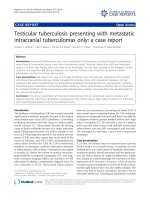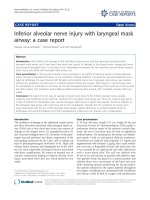Báo cáo y học: "Churg-Strauss syndrome following cessation of allergic desensitization vaccination: a case report" pptx
Bạn đang xem bản rút gọn của tài liệu. Xem và tải ngay bản đầy đủ của tài liệu tại đây (416.1 KB, 4 trang )
JOURNAL OF MEDICAL
CASE REPORTS
Masjedi et al. Journal of Medical Case Reports 2010, 4:188
/>Open Access
CASE REPORT
© 2010 Masjedi et al; licensee BioMed Central Ltd. This is an Open Access article distributed under the terms of the Creative Commons
Attribution License ( which permits unrestricted use, distribution, and reproduction in
any medium, provided the original work is properly cited.
Case report
Churg-Strauss syndrome following cessation of
allergic desensitization vaccination: a case report
Mohammad Reza Masjedi, Saeid Fallah Tafti*, Ali Cheraghvandi, Nader Fayazi, Firouzeh Talischi* and Bahareh Mokri
Abstract
Introduction: Churg-Strauss syndrome is a vasculitis of medium to small sized vessels. Diagnosis is mainly clinical with
findings of asthma, eosinophilia, rhinosinusitis and signs of vasculitis in major organs.
Case presentation: We present a case of a 19-year-old Persian male who developed signs and symptoms of this
syndrome related to hyposensitization treatments for allergy control.
Conclusions: No unifying etiology for the disease can be presented as it is found associated with environmental
factors, medications, infections and is even considered a variant of asthma with predisposition to vasculitic
involvement. Therefore, it is important to recognize this disease and be aware of underdiagnosis because of emphasis
on pathologic evidence. Here, we present a case of allergic desensitization causing Churg-Strauss syndrome in the
absence of other known factors.
Introduction
Churg-Strauss syndrome (CSS) is a vasculitis of medium
to small sized muscular arteries and veins. CSS was first
described in 13 patients with deadly asthma who had the
combination symptoms of asthma and eosinophilia, rhi-
nosinusitis and signs of vasculitis in the heart, pericar-
dium, the nervous and gastroenteric systems and other
vital organs [1]. Even though some consider allergic
asthma, rhinosinusitis and eosinophilia separate of the
CSS, most reports consider this vasculitis a disease by
itself or a variant of asthma which occurs from immune
system involvement such as with the use of medications
like leukotrienes or sudden withdrawal of oral steroids
[2,3]. They also consider environmental factors signifi-
cant in development of primary systemic vasculitides [4].
One of these factors is the influence of severe antigene-
mia (SAg) in inducing vasculitis [3,5]. Presumptively
inhaling allergens, vaccination, desensitizing medications
and even infections and Loeffler's syndrome can behave
as a triggering event against T-lymphocytes and cause the
signs of CSS in the asthmatic population [4,6,7].
Case presentation
The patient was a 19-year-old Persian male with a past
medical history of sinusitis and allergic rhinitis for four
years and episodes of wheezing and shortness of breath
for two years who was admitted for fever, productive
cough, worsening of dyspnea in the past two months.
Two weeks prior to admission, in addition to increased
shortness of breath, blood streaks were present in his
sputum and he developed gradual paresthesia in his right
lower legs. On physical examination, he was in respira-
tory distress and had coarse crackles and generalized ron-
chi and wheezing in the lung bases. The level of SPO
2
upon admission was 74% and increased to 91% with
administration of 6 liters of 40% oxygen via venturi mask.
Our patient's hemodynamics were stable except for tac-
hypnea and he was not febrile. A complete blood count
showed a white cell count (WBC) of 18,000 with 23%
eosinophils with no anemia and the platelet count was
215,000 per cubic millimeter. Liver and renal function
tests, blood coagulation studies and electrolytes were
within normal limits. Our patient's erythrocyte sedimen-
tation rate (ESR) was 3mm/h 15 days prior to admission
and 14mm/h at the hospital. Blood cultures were negative
one week after admission. Urinalysis was normal. Tests
for rheumatoid factor (RF), anti nuclear antibodies
(ANA), circulating anti neutrophil cytoplasmic antibody
(cANCA), perinuclear anti neutrophil cytoplasmic anti-
* Correspondence: ,
Massih Daneshvari Hospital, Department of Pulmonary Medicine, Tobacco
Prevention and Control Research Center (TPCRC), National Research Institute
of Tuberculosis and Lung Diseases, Shahid Beheshti University of Medical
Sciences, DarAbad, Tehran, Postal Code 1955841452, Iran
Full list of author information is available at the end of the article
Masjedi et al. Journal of Medical Case Reports 2010, 4:188
/>Page 2 of 4
body (pANCA) as well as C3, C4 and CH50 were nega-
tive. Skin tuberculin test (PPD) was negative at 72 hours.
Cardiac echography was normal. On the second hospital
day, our patient developed hyperesthesia and severe pain
in his right lower leg which led to a foot drop on the same
side the following day. He underwent EMG (electromyog-
raphy) and NCV (nerve conduction study) studies that
showed neuritis and axonopathy along the common per-
oneal nerve located below the right knee level. He even-
tually underwent bronchoscopy and transbronchial lung
biopsy (TBLB) of the right lower lobe and of mucosa of
trachea and bronchi. Lung pathology showed infiltration
with eosinophilic and limited number of multinucleated
giant cells. Bronchi and lung parenchyma were free of
signs of vasculitis but accumulation of eosinophils in the
alveoli was seen. Bronchoalveolar lavage (BAL) revealed
neither mycobacteria nor cancerous cells. A closer look at
our patient's past medical history revealed desensitiza-
tion vaccination for allergy control. The vaccines were
first administered twice weekly, every Monday and every
Wednesday for four months and again this year, for a
period of three months. He had no history of switching
inhaled steroid medications to oral steroids or the use of
leukotriene antagonists.
During his hospital stay, our patient was treated with
oral steroids and cyclophosphamide and he was dis-
charged two weeks after admission in no respiratory dis-
tress and good general health.
Discussion
CSS is unknown in origin. Suggestions are allergic or
immune mediated. Etiology is considered to be autoim-
mune due to allergic symptoms, immune complex media-
tion 48% are (ANCA, antineutrophil cytoplasmic
antibody) positive, increased T-cell mediated immunity,
elevated immunoglobulin E (IgE) levels and rheumatoid
factor [6]. Also superantigen theory proposes that due to
SAg, vascular wall destruction by autoreative T-cells may
occur or autoreactive B-cells may form antibodies
involved in formation of vasculitis [5]. The latter has been
considered associated with cases of sudden loss of control
over immune reaction as with stopping steroids, leukot-
riene antagonists or in this case probably due to invigora-
tion of the immune system with antigen stimulation.
Here, we have presented the case of allergic desensitiza-
tion causing CSS in the absence of other known factors.
Clinical diagnosis is based on American College of
Rheumatology Criteria which requires the presence of
four or more of the six conditions: asthma, eosinophilia >
10%, neuropathy, migratory or transient pulmonary opac-
ities, abnormalities of the paranasal sinuses and extra-
vascular eosinophils on biopsy. Regularly, a history of
asthma and rhinosinusitis precedes the appearance of the
syndrome itself [8].
Histological diagnosis is by demonstration of vasculitis
that is necrotizing, tissue infiltration with eosinophils and
extra-vascular granulomas are found in a few cases [9].
Asthma is pivotal to the diagnosis and is relatively late
in age of onset. The most common radiological findings
are lobular or centrilobular peripheral consolidation and
nodularity, thickened bronchial walls, inter-lobular sep-
tum, and peri-cardial and pleural effusion [8]. On com-
puted tomography, enlargement of or distortion of
peripheral pulmonary arteries may be seen. The ultimate
diagnosis is by biopsy with open biopsy preferred to
TBLB or sural nerve sampling in case of symptoms [10].
The differential diagnosis includes Wegener's granulo-
matosis, drug reaction, bronchogenic granulomatosis,
fungal and parasitic infections, and malignancy [6].
Included in the differential diagnosis are immune medi-
ated diseases such as idiopathic thrombocytopenic pur-
pura, cryoglobulenemia, and collagen vascular diseases.
Complement is normal or elevated in vasculitis and
malignancy generally does not cause failure of major
organs [10]. Polyarteritis nodosa (PAN) also involves
small and medium sized vessels, and severe renal disease
is common, but eosinophilia is rare [2]. Diagnosis is by
clinical, pathological, and laboratory correlates.
In the case of our patient, asthma was present years
before the disease. The clinical criteria for diagnosis of
CSS were met as well as eosinophilia. Other organ
involvement was cardiac and neurological. Respiratory
symptoms responded well to oral corticosteroids and
cyclophosphamide. Allergic angiitis had not occurred
after the first episode of desensitization treatment,
although he might have had a mild reaction for which
medical treatment was not saught.
Treatment regularly is with prednisone starting at 40-
60 mg a day and the occasional addition of cyclophosph-
amide or azathioprine with the purpose to limit the dis-
ease or spare steroids [2]. In case of fulminant disease or
multi-organ involvement, parenteral corticosteroid such
as methylprednisolone is used. If response to mentioned
treatment is not seen, parenteral immunoglobulin is
administered. Newly experimental medications for unre-
sponsive cases are mycophenolate mofetil and tumor
necrosis factor (TNF)-α blockers (such as etanercept and
infliximab). Treatment is continued at least one month
after remission [1,11]. Uncommon but presented as case
report has been also cardiac function improvement (ejec-
tion fraction increased from 28 to 67%) after a year of
corticosteroid therapy [12].
Hyper-responsiveness to antigenic stimuli may be the
etiologic factor in the development of CSS. In 1998,
Wechsler and colleagues reported eight patients with this
syndrome after a decrease or withdrawal of oral steroids.
Subsequent to this report, many others were made that
associated CSS with the withdrawal of leukotriene antag-
Masjedi et al. Journal of Medical Case Reports 2010, 4:188
/>Page 3 of 4
onists or systemic steroids and this strengthened the the-
ory of unmasking of CSS in chronic and allergic asthma
[2]. Also cases have been attributed to antibiotics such as
erythromycin, azithromycin and roxithomycin and some
metered dose inhalers (bamuterol, salmeterol and nedro-
cromil) as well as the Food and Drug Administration
mentioned fluticasone [1]. Vasculitis has also been
reported with hepatitis B, flu and measles vaccine and
BCG (Bacillus of Calmette and Guerin) inoculation. Also
to be considered is vaccine components such as thimero-
sol or aluminum which have not been shown to have
many side effects [13,14]. Finally, CSS has been associated
with hyposensitizing immunization to candidin, polymi-
crobial and acarian or unspecific antigens [7]. In cases of
PAN which has extreme closeness to CSS, similar reports
with hyposensitization have been observed. In one study,
20 patients with PAN developed vasculitic symptoms
upon hyposensitization treatment for atopic (IgE-medi-
ated) lung disease. Allergic symptoms were present in
patients from less than three months to 10 years. Despite
withdrawal of treatment, vasculitis persisted. Death
resulted in three patients. Fourteen control PAN patients
(without hyposensitization) had less skin involvement
and peripheral eosinophilia (P < 0.05). Signs of circulating
immune complexes and decreased hemolytic comple-
ments, cryoglobulinemia and elevated C1q binding were
present in all subjects. Allergen use was not of one type;
five patients received less than 16 mg of allergenic protein
and anti-allergen precipitating antibodies were not found
[15].
CSS might be under diagnosed because of a focus on
pathologic evidence. Classic histology is seldom found
and is not pathognomonic for diagnosis. Yet, the disease
has distinctive clinical presentation and criteria devel-
oped show the importance of this. It is important to diag-
nose the disease and monitor for relapse among these
patients as it is frequent and requires immediate atten-
tion. Additionally, despite treatment of vasculitis, neuro-
logical symptoms may persist [6].
Conclusions
Although the etiology of this disease is not well known,
both T- and B-cell mediated immunity have been consid-
ered. As noted in this case and many others, etiologies for
vasculitic syndromes and CSS are various and medica-
tions are among them. Cases related to medications are
rare as is the disease incidence itself. A unifying etiology
for disease occurrence can not be distinguished. Maybe
medication related CSS might be related to a drug prepa-
ration technique such as the additives thimerosol or alu-
minum. Yet, this disease is considered immune mediated
and autoimmune mediated and has been seen in other
situations particularly infections, due to environmental
factors it might have multiple etiologies [6].
According to our findings, CSS seems to be developed
after cessation of allergic desensitization vaccination;
however more investigations should be carried out.
Consent
Written informed consent was obtained from the patient
for publication of this case report and any accompanying
images. A copy of the written consent is available for
review from the Editor in Chief of the journal.
Acknowledgements
Authors would like to thank all colleagues at the Masih
Daneshvari Hospital that helped with preparation of this
manuscript.
Competing interests
The authors declare that they have no competing interests.
Authors' contributions
MRM, SFT, AC, and NF participated in planning of case reporting and provided
case presentation and guidance and manuscript was prepared by all authors
including FT and BM. All authors read and approved the final manuscript.
Author Details
Massih Daneshvari Hospital, Department of Pulmonary Medicine, Tobacco
Prevention and Control Research Center (TPCRC), National Research Institute
of Tuberculosis and Lung Diseases, Shahid Beheshti University of Medical
Sciences, DarAbad, Tehran, Postal Code 1955841452, Iran
References
1. Churg J, Strauss L: Allergic granulomatosis, allergic angiitis, and
periarteritis nodosa. Am J Pathol 1951, 27(2):277-301.
2. Fallah Tafti S, Mansouri D, Masjedi MR, Marashian M, Faridian D: Churg
Strauss syndrome after introducing oral steroid to inhaler-a report of
three cases. Iran J Allergy Asthma Immunol June 2006, 5(2):89-94.
3. Rolla G, Guida G, Heffler E: Churg-Strauss syndrome: still a clinical
challenge. Expert Rev Clin Immunol 2007, 3(6):833-837.
4. Lane SE, Watts RA, Bentham G, et al.: Are environmental factors
important in primary systemic vasculitis? A case-control study. Arthritis
Rheum 2003, 48:814-823.
5. Tervaert JW, Popa ER, Bos NA: The role of superantigens in vasculitis.
Curr Opin Rheumatol 1999, 11:24-33.
6. Gross WL, Reinhold-Keller E: Churg-Strauss Syndrome. Orphanet
Encyclopedia 2002:1-7 [ />CSS.pdf].
7. Serna-Candel C, Moreno-Verez O, Soriano V, et al.: Churg-Strauss
syndrome triggered by hyposensitization to Alternaria fungus. Clin
Rheumatol 2007, 26:2195-2196.
8. Jeong YJ, Kim K, Seo IJ, et al.: Eosinophilic lung diseases: a clinical
radiologic, and pathologic overview. Radiographics 2007, 27:617-637.
9. Lanham JG, Elkon KD, Pusey CD, et al.: Systemic vasculitis with asthma
and eosinophilia: a clinical approach to Churg-Strauss syndrome.
Medicine (Baltimore) 1984, 63(2):65-81.
10. Semple D, Keogh J, Forni L, et al.: Clinical review: vasculitis in the
intensive care unit-part 2: treatment and prognosis. Critical Care 2005,
9:193-197.
11. Semple D, Keogh J, Forni L, et al.: Clinical review: vasculitis on the
intensive care unit-part 1: diagnosis. Critical Care 2005, 9:92-97.
12. Takahashi N, Horita M, Tatsukawa M, et al.: Allergic granulomatosis and
angiitis with severe cardiac disease: a case in which cardiac function
was extremely improved by long-term steroid therapy. Intern Med
1992, 31(4):534-539.
13. Vanoli M, Scorza R, et al.: A case of Churg-Strauss vasculitis after hepatitis
B vaccination. Ann Rheum Dis 1998, 57:256-257.
Received: 10 January 2009 Accepted: 22 June 2010
Published: 22 June 2010
This article is available from: 2010 Masjedi et al; licensee BioMed Central Ltd. This is an Open Access article distributed under the terms of the Creative Commons Attribution License ( which permits unrestricted use, distribution, and reproduction in any medium, provided the original work is properly cited.Journal of Medical Case Repo rts 2010, 4:188
Masjedi et al. Journal of Medical Case Reports 2010, 4:188
/>Page 4 of 4
14. Allen MB, Cockwell P, Page RL: Pulmonary and cutaneous vasculitis
following hepatitis B vaccination. Thorax 1993, 48(5):580-581.
15. Phanuphak P, Kohler PF: Onset of polyarteritis nodosa during allergic
hyposensitization treatment. Am J Med 1980, 68(4):479-485.
doi: 10.1186/1752-1947-4-188
Cite this article as: Masjedi et al., Churg-Strauss syndrome following cessa-
tion of allergic desensitization vaccination: a case report Journal of Medical
Case Reports 2010, 4:188
